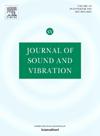位移限制下预拉伸SMA弹簧连接的调谐质量阻尼器框架基于能量的减振分析
IF 4.3
2区 工程技术
Q1 ACOUSTICS
引用次数: 0
摘要
在实际结构中,由于空间的限制,当质量块的行程受到限制时,调谐质量阻尼器的阻尼效果将受到限制。在这种情况下,保持TMD阻尼器对主体结构的良好阻尼效果至关重要。为了实现这一目标,本文开发了一种新型的非线性TMD阻尼器来抑制框架结构的振动,该阻尼器将质量块连接到预拉伸的超弹性SMA弹簧上,并配有位移限制装置。这种新型TMD阻尼器充分利用了预拉伸SMA弹簧和附加粘弹性材料的位移限制装置的耗能优势。首先,建立了新型非线性TMD阻尼器附加结构的运动方程,并通过振动台试验验证了框架系统的力学模型。然后,通过最小化新阻尼器与仅配置SMA弹簧的TMD阻尼器的最大输入能量平均值之间的差异,对位移限制装置和冲击间隙参数进行了优化。在优化过程中,冲击力被限制在一个可接受的值。数值结果表明,新型非线性阻尼器与仅采用预拉伸SMA弹簧的TMD阻尼器的控制性能基本相同。无论采用哪种TMD阻尼器,相同的输入能量都会导致框架的峰值响应相同。与撞击式TMD相比,由于用预拉伸SMA弹簧代替直线钢弹簧,在某些情况下,该阻尼器的峰值响应消减率提高了16.4%。最大撞击力平均降低33%左右,对保护限排装置有重要意义。本文章由计算机程序翻译,如有差异,请以英文原文为准。
Energy-based vibration reduction analysis of frame with tuned mass damper connected to pre-stretched SMA springs under limitation of displacement
When the stroke of mass block is restricted due to the limitation of space in a real structure, the damping effectiveness of tuned mass damper (TMD) will be limited. In this situation, it is crucial to maintain a good damping effect of the TMD damper on a main structure. To achieve this goal, this paper develops a new nonlinear TMD damper to suppress the vibration of the frame structure, in which the mass block is connected to pre-stretched superelastic SMA springs and equipped with a displacement-limit device. This new TMD damper fully utilizes the energy dissipation advantages of both the pre-stretched SMA springs and the displacement-limit device attached with an additional viscoelastic material. At first, the motion equation of the structure attached with the new nonlinear TMD damper is established and the mechanical model of the frame system is verified by shaking table tests. Afterwards the parameters of the displacement-limit device and the pounding gap are optimized through minimizing the discrepancy between the mean value of maximum input energy in the structure with the new damper and that with the TMD damper equipped with only the SMA springs. During the optimization, the pounding force is restricted to an acceptable value. The numerical results show that the control performances of the new nonlinear damper and the TMD damper with only the pre-stretched SMA springs are almost the same. No matter which TMD damper is used, the identical input energy will lead to the same peak responses of the frame. Compared with the pounding TMD, because of the replacement of the linear steel springs with the pre-stretched SMA springs, the proposed damper can increase the reduction ratio of peak responses by 16.4 % in some cases. And the maximum impact force on average is reduced by about 33 %, which is significant to protect the displacement-limit device.
求助全文
通过发布文献求助,成功后即可免费获取论文全文。
去求助
来源期刊

Journal of Sound and Vibration
工程技术-工程:机械
CiteScore
9.10
自引率
10.60%
发文量
551
审稿时长
69 days
期刊介绍:
The Journal of Sound and Vibration (JSV) is an independent journal devoted to the prompt publication of original papers, both theoretical and experimental, that provide new information on any aspect of sound or vibration. There is an emphasis on fundamental work that has potential for practical application.
JSV was founded and operates on the premise that the subject of sound and vibration requires a journal that publishes papers of a high technical standard across the various subdisciplines, thus facilitating awareness of techniques and discoveries in one area that may be applicable in others.
 求助内容:
求助内容: 应助结果提醒方式:
应助结果提醒方式:


